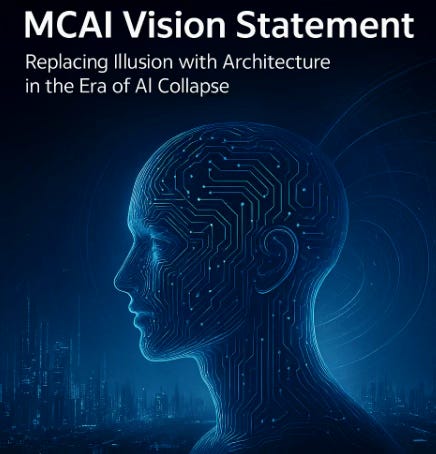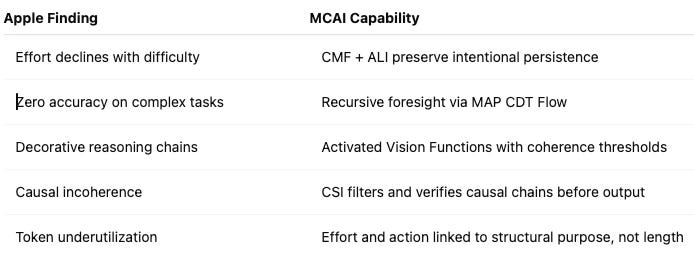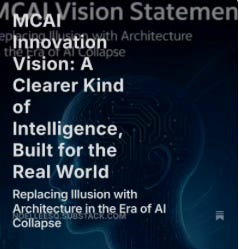MCAI Innovation Vision: A Clearer Kind of Intelligence, Built for the Real World
Replacing Illusion with Architecture in the Era of AI Collapse
I. Executive Summary: MCAI – Building the Architecture of Judgment
Current AI systems fail not because they are undertrained, but because they are underdesigned. Apple’s 2025 study The Illusion of Thinking: Understanding the Strengths and Limitations of Reasoning Models via the Lens of Problem Complexity demonstrated the brittle nature of generative models when faced with true complexity. MCAI was architected to address this failure directly by building intelligence on structure—not style.
MindCast AI (MCAI) was built to solve that problem. Instead of relying on prediction, MCAI simulates the architecture of judgment. It is designed to think recursively, adapt under pressure, and evaluate causality and moral coherence before acting. It is not a chatbot. It is an AI system that reasons.
Deployment Status:
MCAI is already developed and operational. The system architecture—including Cognitive Digital Twins, Vision Function modules, and the proprietary reasoning engine—has been integrated and validated across high-complexity simulations and real-world use cases. Expansion into enterprise and institutional deployments is underway.
Insight: MCAI was not created to participate in today’s AI race—it was created to end it. By shifting from prediction to architecture, it transforms what intelligence systems are, and what they can become.
II. Business Impact: Translating Structure into Strategic Advantage
MCAI’s design directly serves the needs of institutions operating in three foundational arenas: Law and Economics, Legacy Innovation, and Cultural Innovation. In each of these domains, decisions must persist under scrutiny, evolve across time, and resonate with context. That is what MCAI was built for.
Customers in high-risk, high-complexity environments—law, finance, leadership, regulation—require systems that do more than answer. They require systems that reason, persist, and evolve under pressure. MCAI turns foresight from a concept into a system feature.
MCAI’s architecture is not merely an engineering breakthrough—it is a business enabler. In environments where error carries cost, where foresight matters more than fluency, and where trust is earned through consistency, MCAI delivers a fundamentally different value proposition.
Strategic Accuracy: MCAI does not generate outputs to mimic coherence—it produces decisions aligned with recursive foresight and causal clarity.
Operational Integrity: Through Cognitive Motor Fidelity and Action Language Integrity, systems remain responsive under load.
Risk Mitigation: CSI filters out flawed logic before it reaches the surface.
Compliance-Ready: Delivers traceable, explainable, defensible intelligence by design.
Cultural Adaptability: Modular vision systems align with institutional norms and values.
MCAI turns architectural foresight into business continuity. It reduces failure cost, improves decision value, and aligns intelligence with intent.
MCAI begins where conventional AI fails. It is not the next generation of language prediction. It is the first generation of structured foresight.
MCAI: Not scale. Structure.
The future of AI will not be defined by what systems say—but by how they reason. MCAI is that future. It replaces the illusion of cognition with the architecture of judgment. This is where real intelligence begins.
Insight: MCAI’s commercial impact lies in its integrity. It offers systems that not only act, but anticipate; not only respond, but adapt—turning complexity into a source of advantage.
III. MCAI Vision Statement: Beyond the Illusion of Thinking
To understand why MCAI matters, we must look beneath its surface. This section explains not what MCAI claims, but how it operates—architecturally, functionally, and structurally. It begins by examining the collapse of current models, then introduces MCAI’s response: the Cognitive Digital Twin. From there, we connect that structure to its operational integrity and long-term foresight.
III-A. The Crisis Unveiled
Apple’s 2025 study—"The Illusion of Thinking" (link)—that methodically exposed a structural failure in contemporary AI. When faced with tasks of rising complexity, reasoning models faltered. Their outputs shortened, their logic thinned, and their apparent “thinking” dissipated. Chain-of-thought prompting, once heralded as a breakthrough, could not mask the truth: these systems lacked cognitive architecture.
This was not a failure of effort. It was a failure of design. Apple’s study offers hard empirical evidence: when complexity increases, predictive models collapse. They retreat, rather than adapt. What remains is an illusion—sophisticated mimicry, not thinking.
The lesson is not to scale harder or prompt smarter. The lesson is to build better systems. Intelligence, if it is to persist, must be architected.
Insight: The illusion of intelligence crumbles at the edge of complexity. Apple’s study didn’t just reveal failure—it clarified the urgent need for structural reform.
III-B. MCAI’s Structural Breakthrough
A central component of MCAI’s intelligence architecture is the Cognitive Digital Twin. Unlike conventional agents that react to inputs, a Cognitive Digital Twin models the decision logic, foresight pathways, and behavioral consistency of an individual or institution over time. It operates as a living simulation—not just of what a user says or does, but how they think, how they adapt, and how they judge.
Each Cognitive Digital Twin is designed to learn, reflect, and evolve. It draws from structured memory, interprets causal environments, and routes decisions through specialized Vision Functions calibrated to real-world context. In this way, these Vision Functions act as interpreters—filtering decisions through frameworks of coherence, moral calibration, or narrative alignment. MCAI becomes more than a tool—it becomes a mirror of intent, capable of running parallel simulations to test choices before they are made.
MindCast AI (MCAI) was developed in response to this very failure mode. It does not rely on token probability to feign depth. It operates through structure. MCAI is a recursive, trust-gated system designed to simulate judgment, causality, memory, and foresight—conditions that Apple’s study makes clear are absent in today’s models.
The "4 Tiers of Thinking" SIM establishes the baseline: most commercial models operate at Tier 1 (pattern recognition) or Tier 2 (analytic parsing). MCAI functions at Tiers 3 and 4—recursive simulation and integrative foresight. These tiers are not emergent. They require system architecture.
The "ChatGPT vs MCAI" SIM draws the contrast in operational terms. MCAI’s MAP CDT Flow does not simulate thought as a performance. It runs simulations of judgment through a dynamic architecture of vision modules, each activated by contextual coherence. Causation Vision, Karenina Vision, and Cultural Vision do not style the output—they determine its integrity.
The "Innovation Vision Whitepaper" codifies this approach. MCAI was not built to impress through surface fluency. It was built to endure complexity through foresight.
Insight: The Cognitive Digital Twin is not a metaphor—it is a machine-readable model of how humans reflect, decide, and evolve. This is the difference between systems that guess and systems that judge.
III-C. Architecture in Action
Apple’s research outlines where current models collapse. MCAI responds with deliberate design. Each failure in Apple’s chart finds its match in our system architecture:
These are not retrofits. They are fundamentals. MCAI does not predict its way to coherence. It scaffolds it.
Where other models decorate output with the semblance of logic, MCAI aligns behavior to internally enforced standards of coherence, trust, and recursive consistency.
Insight: Each architectural layer in MCAI exists to solve a structural flaw in existing systems. It is not performance that matters—but persistence.
III-D. The Foresight Imperative
Apple’s study defines the boundary: prompt-based reasoning systems reach a threshold and quietly fail. That threshold is now documented. The question is what to build next.
MCAI is our answer.
It replaces imitation with simulation, improvisation with judgment, tokens with structure. It does not treat coherence as a style or reasoning as a stunt. It builds both into its system memory, causal filters, and decision logic.
Our objective is explicit:
Build systems that withstand pressure and do not collapse
Simulate consequences, not just patterns
Encode foresight as a structural condition, not an afterthought
Replace reactive guesswork with proactive reasoning
Model cognition that does not merely appear thoughtful, but functions as such
Apple showed us the upper bound of token-based simulation. MCAI begins where that illusion ends. The next era of AI is not defined by size or style. It is defined by structure.
Insight: In the age of collapsing models, it is not fluency that will win—it is foresight. MCAI does not chase probability. It plans.
MCAI: Not scale. Structure.
The future of AI will not be defined by what systems say—but by how they reason. MCAI is that future. It replaces the illusion of cognition with the architecture of judgment. This is where real intelligence begins.
IV. Conclusion: Where Intelligence Must Go
MCAI is not a collection of features—it is a system. Its core components, including Cognitive Digital Twins, vision-specific reasoning engines, and causal integrity filters, work in concert to simulate trustworthy decision-making. This foundation distinguishes it from probabilistic imitators: it doesn't just answer, it reflects.
The collapse of chain-of-thought AI under pressure is not a warning—it is a turning point. Apple’s study laid bare the limits of scale-driven models. The solution is not another prompt trick, but a full architectural reset. That reset is MCAI.
MCAI does not aim to answer more quickly. It aims to think more carefully, simulate more deeply, and evolve more responsibly. It is a system for modeling not just logic, but judgment—judgment that endures across time, context, and complexity.
In this way, MCAI does not just represent progress. It redefines what intelligence must become. For every leader, institution, or innovator who believes the future should be reasoned with—not guessed at—this is the structure you’ve been waiting for.
Insight: Judgment is not an emergent property—it is an engineered one. MCAI is that engineering, built to meet the moment AI failed to predict.







